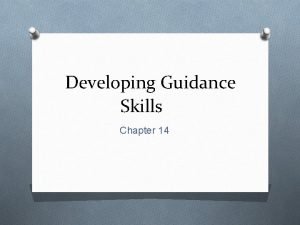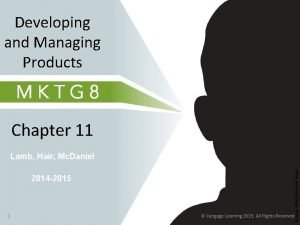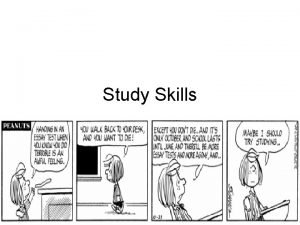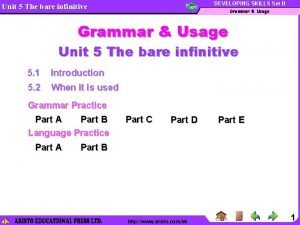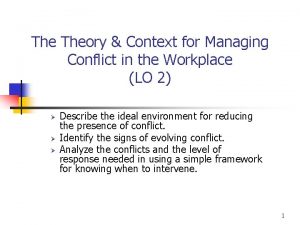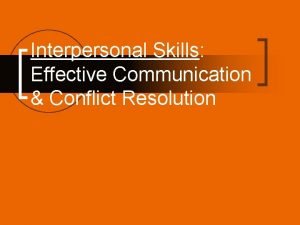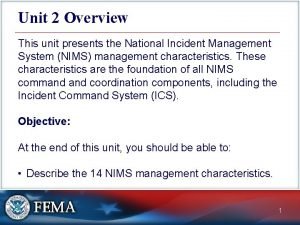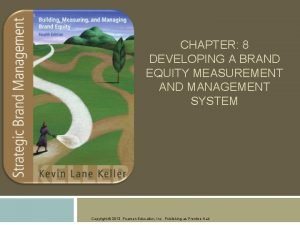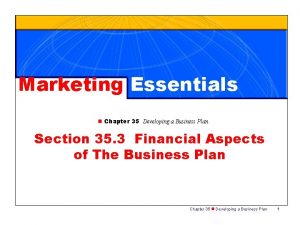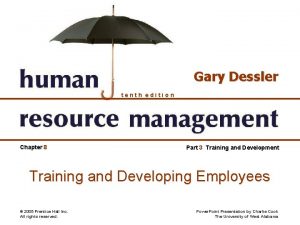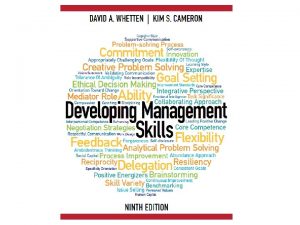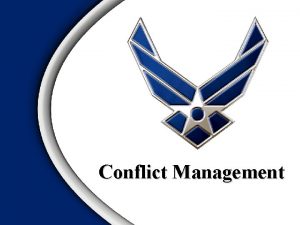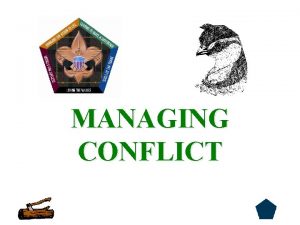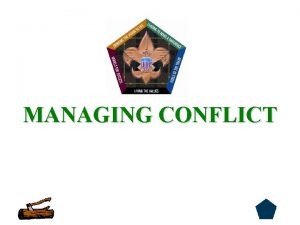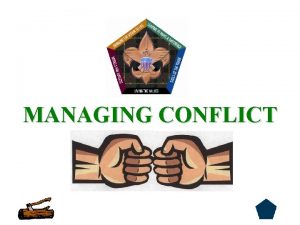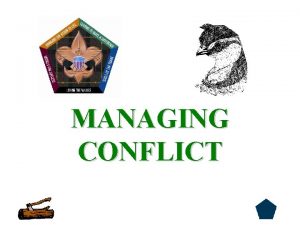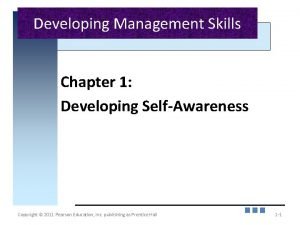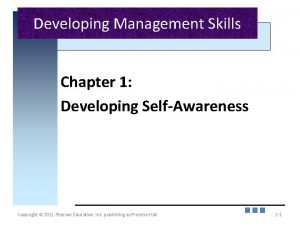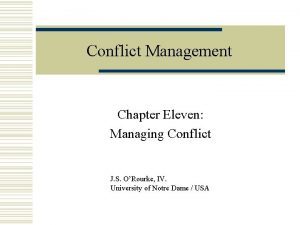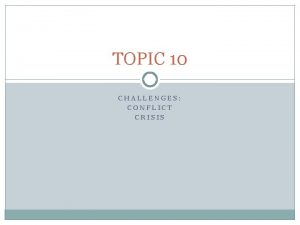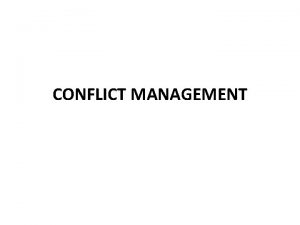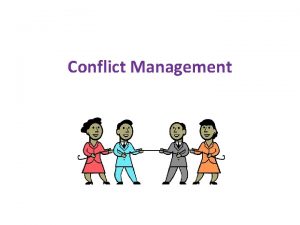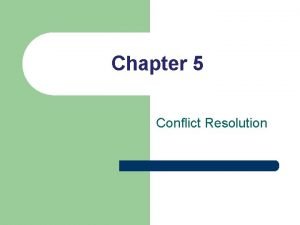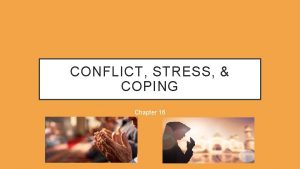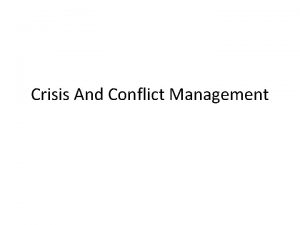Developing Management Skills Chapter 7 Managing Conflict Copyright

































- Slides: 33


Developing Management Skills Chapter 7: Managing Conflict Copyright © 2016 Pearson Education, Inc. 7 -1

Learning Objectives 1. Diagnose the focus and source of conflicts 2. Utilize appropriate conflict management strategies 3. Resolve interpersonal confrontations through collaboration Copyright © 2016 Pearson Education, Inc. 7 -2

Interpersonal Conflict Management • The failure to confront conflict effectively is a leading cause of business failure. • Constructive conflict can spark creativity, energy, and personal improvement • Many people intellectually accept the value of conflict but feel uncomfortable when they themselves get involved in it. • conflict is both inevitable and beneficial in effective organizations 4

The Relationship Between Conflict and Outcomes holding constant the nature of the conflict and how well it is resolved, a moderate level of conflict appears to be 7 -3 healthy for most organizations

Rules of Engagement for effective conflict management • Work with more information • Focus on the facts • Develop multiple alternatives • Share agreed-upon goals • Inject humor into the decision process • Maintain a balanced power structure • Resolve issues without forcing consensus Copyright © 2016 Pearson Education, Inc. 7 -4

Types of Conflict Copyright © 2016 Pearson Education, Inc. 7 -5

Conflict Focus People-focused: ü “In-your-face” confrontations in which emotions are fueled by moral indignation ü are negative conflicts that involve accusations of harm, injustice, or feelings of resentment between conflicting parties. Issue-focused: ü negotiations in which participants agree how to allocate scarce resources ü can be positive or negative, and involve different parties representing the interests of their own groups, functions, or organizations. 7 -6

Four Sources of Interpersonal Conflict Personal Differences: Conflicts stem from personal values and needs Copyright © 2016 Pearson Education, Inc. 7 -7

Four Sources of Interpersonal Conflict Informational Deficiencies: Conflicts evolve from misinformation and misunderstanding Copyright © 2016 Pearson Education, Inc. 7 -8

Four Sources of Interpersonal Conflict Role Incompatibility: Conflicts evolve from the perception that assigned goals and responsibilities compete with those of others. Copyright © 2016 Pearson Education, Inc. 7 -9

Four Sources of Interpersonal Conflict Environmentally Induced Stress: Conflict results from the stressful events of the organizational environment. Copyright © 2016 Pearson Education, Inc. 7 -10

Selecting the Appropriate Conflict Management Approach • The five conflict management styles vary on two key dimensions shown in Figure 7. 3: – Cooperativeness is the degree to which parties seek to satisfy the other’s concerns – Assertiveness is the degree to which parties seek to satisfy their own concerns. • Effective managers choose the appropriate style from the following list to fit the situation and relationship they are in. © 2007 by Prentice Hall 13

Conflict Resolution Insert figure 7. 3 Copyright © 2016 Pearson Education, Inc. 7 -11

Forcing • Satisfy personal needs at the expense of the other person • Formal authority, bullying, manipulation, etc. • Outcome: You feel vindicated; other person feels defeated Copyright © 2016 Pearson Education, Inc. 7 -12

Avoiding • Neglect interests of both parties by sidestepping or postponing • Reflects inability to handle emotion of conflict • Outcome: Nothing (or things get worse) Copyright © 2016 Pearson Education, Inc. 7 -13

Accommodating • Satisfy other party’s concerns but neglect your own • Preserve a relationship at the expense of genuine appraisal of issues • Outcome: Other person takes advantage of you; decreased power and credibility Copyright © 2016 Pearson Education, Inc. 7 -14

Compromising • Seek partial satisfaction for both parties • Expedient, not effective, solutions • Outcome: Gamesmanship and suboptimal resolutions Copyright © 2016 Pearson Education, Inc. 7 -15

Collaborating • Seek to address concerns of both parties • No assignment of blame • Outcome: When collaborating is possible, problem likely to be resolved Copyright © 2016 Pearson Education, Inc. 7 -16

Which approach is best? While we are predisposed to one approach, no single approach is the best; Effective managers use a variety of approaches Copyright © 2016 Pearson Education, Inc. 7 -17

Selecting the Right Strategy Two general negotiation strategies are closely linked to the five conflict management strategies: Distributive bargaining : ‒Negotiation focus on “Dividing up a fixed pie” –assumes there will be winners and losers, so parties see one another as competitors or adversaries. Integrative : “Expanding the pie” –is comparable to the collaborative form of conflict management; it strives for a solution that is best for both parties. 7 -18

Situational Considerations • The correct approach to conflict depends on two factors – Personal preferences revolve around ethnic culture, gender, and personality type. – Situational variables include the importance of the issue, the importance of the relationship, the relative power of the parties, and time constraints. • When the issue is very important, forcing or collaboration may be appropriate. • When the relationship is important, accommodation and collaboration may be preferable.

Conflict Resolution Outcomes by Type and Method Copyright © 2016 Pearson Education, Inc. 7 -20

A ‘Default Strategy’ Of all the approaches, collaboration generally yields the best outcomes; However, it is also the most difficult to implement Copyright © 2016 Pearson Education, Inc. 7 -21

Resolving Interpersonal Confrontations Using the Collaborative Approach • The following six steps are recommended for implementing the collaborative approach: 1. 2. 3. 4. 5. 6. Establish superordinate goals. Both parties identify the goals they share, thus establishing a basis for mutual benefits. Separate the people from the problem. Identify the “real issue” or problem. Focus on interests, not positions. Identify the interests, or underlying reasons behind demands or positions. Invent options for mutual gain. Develop creative and mutually agreeable solutions. Use objective criteria for evaluating alternatives. Build fairness into the process by developing criteria for judging alternatives. Define success in terms of real gains, not imaginary losses. Seek mutual gains in a resolution. 25

Four Phases of Collaborative Problem Solving 1. Problem Identification which sets the tone for the entire process 2. Solution Generation 3. Action Plan Formulation and Agreement 4. Implementation and Follow-Up § The following steps are prescribed for working through these four phases in each of three roles: initiator, responder, and mediator. 7 -24

Initiator – Problem Identification 1. Maintain personal ownership of the problem by stating the problem as your own and showing accountability for your feelings. 2. Succinctly describe your problem in terms of behaviors, consequences, and feelings. 3. Avoid drawing evaluative conclusions and attributing motives to the respondent. 4. Persist until understood, using variation in how you express the problem, but not denying the problem. 5. Encourage two-way discussion. 6. Manage the agenda by approaching multiple or complex problems incrementally

Initiator – Solution Generation 1. Focus on commonalities as the basis for requesting a change and in generating a solution. Responder – Problem identification. 1. Establish a climate for joint problem solving by showing genuine interest and concern. 2. Seek additional information about the problem by asking questions. 3. Agree with some aspect of the complaint. Initiator – Solution Generation 1. Ask for suggestions of acceptable alternatives 7 -26

Mediator – Problem identification 1. Acknowledge that a conflict exists and propose a problem-solving approach for resolving it. 2. In seeking out the perspectives of both parties, maintain a neutral posture regarding the disputants - if not the issues. 3. Serve as a facilitator, not as a judge. 4. Manage the discussion to ensure fairness by keeping the discussion issue oriented, not personality oriented. Mediator – Solution generation 1. Explore options by focusing on interests, not positions. 2. Make sure all parties fully understand support the solution, and establish a mechanism for follow up. 29

Summary Model of Conflict Management Insert figure 7. 6 Copyright © 2016 Pearson Education, Inc. 7 -31

Behavioral Guidelines • Collect information on the sources of conflict • Examine relevant situational considerations Copyright © 2016 Pearson Education, Inc. 7 -32

Behavioral Guidelines • Take into consideration your personal preferences for using the conflict management approaches • Utilize the collaborative approach unless conditions dictate the use of an alterative approach Copyright © 2016 Pearson Education, Inc. 7 -33

Copyright Information Copyright © 2016 Pearson Education, Inc. 7 -34
 Chapter 11 developing and managing products
Chapter 11 developing and managing products Developing guidance skills
Developing guidance skills Chapter 17:1 developing job keeping skills
Chapter 17:1 developing job keeping skills Brand &+product type l1
Brand &+product type l1 Developing and managing products
Developing and managing products Developing and managing products
Developing and managing products Developing and managing products
Developing and managing products Managing conflict and negotiation
Managing conflict and negotiation Indirect and direct guidance
Indirect and direct guidance Developing effective study habits
Developing effective study habits Grammar usage set b答案
Grammar usage set b答案 Developing effective reading skills
Developing effective reading skills Developing facilitation skills
Developing facilitation skills Stella ting toomey
Stella ting toomey Mainwaring strategies for managing conflict
Mainwaring strategies for managing conflict Managing stress and conflict in the workplace
Managing stress and conflict in the workplace Ways of managing conflict in the community
Ways of managing conflict in the community Managing conflict theory
Managing conflict theory Internal and external conflict worksheet
Internal and external conflict worksheet What is conflict and conflict resolution?
What is conflict and conflict resolution? Internal and external conflict definition
Internal and external conflict definition Conflict resolution skills
Conflict resolution skills Mdm project deliverables
Mdm project deliverables Nims management characteristics
Nims management characteristics Brand equity charter
Brand equity charter Developing a global management cadre
Developing a global management cadre Intrapersonal relationship skills
Intrapersonal relationship skills Soft skills vs hard skills worksheet pdf
Soft skills vs hard skills worksheet pdf Essential skills ontario
Essential skills ontario Chapter 35 developing a business plan
Chapter 35 developing a business plan Chapter 8 training and developing employees
Chapter 8 training and developing employees Chapter 15 developing fraction concepts
Chapter 15 developing fraction concepts Chapter 35 developing a business plan
Chapter 35 developing a business plan Chapter 2 developing marketing strategies and plans ppt
Chapter 2 developing marketing strategies and plans ppt

